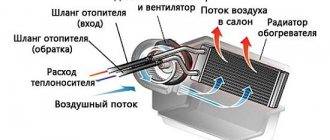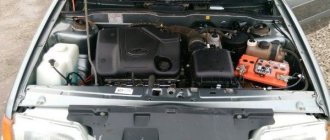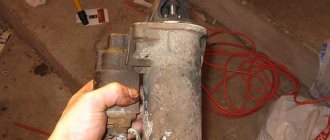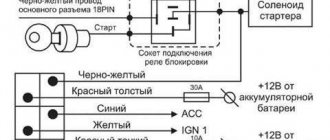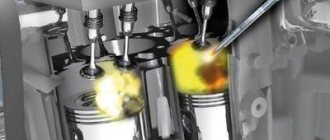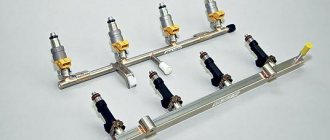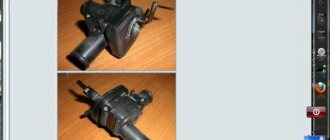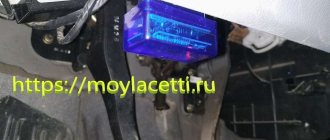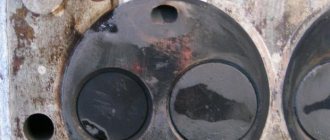- Malfunctions in the cooling system
- Clogged radiator of the VAZ 2114 stove
- How to replace a heater radiator?
- Malfunction of the VAZ 2114 stove valve
- Signs of faucet failure
- Faucet replacement process
Owners of VAZ 2114 cars sometimes encounter such a problem as a malfunctioning stove. This breakdown causes especially great inconvenience in winter: not only does it become cold in the cabin, but the windshield is also covered with an icy crust, blocking the view. If your VAZ 2114 stove also does not work, you must first find the cause of the malfunction. Why does the VAZ 2114 stove: does not heat well, does not heat, does not work?
Heating system VAZ 2114 - regulators
Problems with the interior heater can arise for various reasons, ranging from electrical wiring to wear and tear on the cooling system pump.
Next, we will look in detail at the main reasons for a non-functioning or poorly functioning stove, where you will find a solution to repair your heater. As a rule, all heating system malfunctions can be divided into two categories:
- Cold or slightly warm air is blowing from the air ducts.
- The heater does not turn on or does not work in all modes.
First, let's look at the reasons why the stove sometimes works worse or doesn't heat at all.
The role of the thermostat in the life of a car
A thermostat is a part that serves to regulate the temperature in the cooling system of a vehicle. Until the coolant temperature is maintained within 80 degrees, it is in a closed state. If the temperature rises, the thermostat opens and thereby sends the heated liquid in a “large circle” - through the radiator, thereby allowing it to cool. The most difficult period of operation for the thermostat is summer, when it is above +30 degrees Celsius outside the window. In winter, it “rests” if there are no problems with other automotive components.
If the thermostat does not work, the stove will still heat. That is, if it is stuck in the open position, the air will be constantly cooled (by circulating in a large circle). In addition to the fact that when the heater is turned on, only cold air will blow, other automotive components will also suffer. A thermostat operating in the wrong mode will not be able to provide the optimum temperature to the engine, which, in turn, will lead to a decrease in engine life, as well as to higher fuel consumption.
Stove motor
This is another reason why the stove does not heat up on the Lada Kalina. But if in previous cases, when the heater was turned on, a distinct sound of the fan was heard, then here it will be absent. First of all, you should check the serviceability of the fuse in the block. On Kalina, element F5 is responsible for the operation of the heater motor. Sometimes the mechanism may work, but with strange sounds or interruptions.
So, we found out the malfunction of the stove on Kalina and how to fix this problem.
The car's heating system must be in good working order regardless of the time of year. But many people think about this only when cold weather sets in. The efficient operation of the Lada Kalina heater ensures a comfortable stay in the cabin. The heating system does not fail so often, but timely maintenance is also important for it.
Why doesn't the heater blow after replacing the thermostat?
If the thermostat is new, and after replacing it the stove does not blow heat, it means that either this part is faulty, or the reason lies in something else. In this case, you need to remove the thermostat and turn on the stove. If it heats up, then the reason is in the thermostat: it is faulty and needs to be returned back to the store. If not, you will have to look for the reason in other automotive components.
Fan doesn't work
The most common reason. Air does not enter the cabin at all. Naturally, the stove will work, but its “power” is very small to heat the entire cabin. In this case, you will have to replace the fan or the electronics that control it. In some cases, replacing the corresponding fuse is sufficient.
Low antifreeze level
Insufficient coolant level can also be considered as a reason for cold air entering the cabin. Although this is unlikely, since most cars are equipped with special antifreeze level sensors. For example, if coolant leaks out due to a hole in the tank or a leak in the radiator pipes, that is, almost cold liquid enters the stove, only cold air will flow into the cabin. To fix this problem, just add antifreeze or antifreeze to the required level.
Heater radiator clogged
In this case there may be several reasons:
- use of water - it forms scale on the walls of the system, and also causes rusting of metals;
- improper mixing of cooling materials (antifreeze and antifreeze), which leads to precipitation and clogging of thin radiator pipes;
- eliminating radiator leaks with sealants. This method is called “treat - cripple”. Due to excess sealant, the passages in the radiator are clogged, which does not allow the liquid to circulate normally and thereby “heat up”.
The engine pump has failed
This is a pump that serves to pump hot liquid throughout the system. That is, the pump leads hot liquid from the main engine block through the pipes and then directs it to the radiators for the purpose of cooling (or heating the interior). The most common pump breakdowns are as follows:
- the pump is jammed – its internal part – the “impeller” or the pump as a whole – does not rotate;
- the crankshaft belt has broken, which is why the pump does not rotate, which is why the stove does not heat;
- the use of low-quality coolants that “eat” the inside of the impeller. Physically, the pulley of the part rotates, but the fluid is “pumped” through the system at the lowest possible level. In this case, the stove will also not heat.
Reasons why the stove in Gazelle Business does not heat. Fix it yourself
Any violation of the operating regime and, as a result, the stove in Gazelle Business does not heat.
But more often than not, the heater stops working properly for no apparent reason. For example, when power is applied, the fan turns on and blows warm air, but as soon as you start the engine and heater, it either turns off completely or blows cold air. On new cars, the stove may fail after a few weeks.
The stove in the Gazelle Business does not heat for reasons not directly related to its design. For example, if the thermostat malfunctions, or if there is a failure in the on-board power supply system.
Insufficient coolant level
This is now unlikely, because many modern cars have antifreeze level sensors. However, such cases do occur (say, in cars of previous generations). Imagine the antifreeze or antifreeze (maybe due to leaking radiators or pipes), the heater does not receive sufficiently heated liquid, and it is practically cold, the fan is blowing, and the air is cold (it simply does not heat). You need to add coolant to the level ( read how to do this here ). Also, if radiators or pipes are leaking, then the leak must be eliminated.
Radiator
Every car has this element. In addition to the main one, a cabin radiator is also required. It is a little smaller, but the efficiency of the stove depends on its condition. So, this element may simply become clogged.
The element may also become dirty from the outside. So, honeycombs often suffer from fluff and dry leaves. The way out of the situation is to externally wash the element. Performed on a removed radiator.
Heater radiator is clogged
There may be several reasons:
The first is improper mixing of antifreeze and antifreeze . For example, in G13 you filled in, say, G11 or even antifreeze, then a sediment may appear that will quickly clog all the thin radiator pipes.
Secondly, they poured water. Water not only causes rusting of metals in the system, but also forms scale on the walls.
Third, they eliminated leaks in the heater radiator or main radiator using all kinds of sealants. On the one hand we heal, on the other we cripple. The passages in the radiator can be clogged with excess of this sealant; the liquid cannot circulate normally in it, and, accordingly, heat it up, which means it will not really heat it. True, your engine may show high temperatures, at the limit level (the main thing is not to overheat it). You need to either flush the system, clean the radiator, or simply replace the radiator.
Dependence of the appearance of an air lock in the cooling system on the expansion tank cap
When the liquid in the cooling system is heated, it expands and pressure in the system increases. In order to prevent the system from rupturing, the cap of the expansion tank must release excess air when the pressure rises to 1.3 atmospheres. When cooling, the liquid and air compress and a vacuum appears in the system. To prevent air from being sucked in from under the pipes, the cover must freely allow air into the expansion tank.
Often these covers are of poor quality or simply oxidize and stop normally letting air in and out from outside, which causes air to be sucked in at weak points and, accordingly, the system is re-aired. It also happens that the cover valves freeze when the engine cools down.
To troubleshoot the lid, try sucking air out of it from the back side; if air does not flow in or it comes in with obvious force, then it’s time to change the cover. The presence of freezing is checked in the following way: leave the heated car until it cools completely, then unscrew the lid and look at the valves; if they are completely covered in ice, then the problem is condensation. In case of freezing, you can try treating the lid with silicone grease or VD-shkoy.
The last cover I took and it was the most successful:
Here's the other side:
There is also another option for dealing with bad caps - unscrewing them in winter to allow free air access in both directions through the threads. But keep in mind that in this case the maximum boiling point of the coolant will decrease.
The car's heating system must be in good working order regardless of the time of year. But many people think about this only when cold weather sets in. The efficient operation of the Lada Kalina heater ensures a comfortable stay in the cabin. The heating system does not fail so often, but timely maintenance is also important for it.
Engine thermostat faulty
Now about more complex breakdowns. If everything is fine with the stove itself, the fan works, but does not heat well, then the problem may be in the engine thermostat.
The thermostat serves to regulate the so-called “cooling circles”. When we start the engine, the coolant circulates in a “small circle”; the engine and the interior heater are involved here. Thus, warming up occurs much faster. After the coolant has warmed up, the thermostat opens a “large circle” and the heated liquid has already flowed to the main radiator, which is located under the hood. This is done in order not to overheat the motor if there is excessive overheating.
BUT, depending on time or the quality of the coolant, the thermostat may fail and not close the “big circle”, but always drive around it. Sometimes an absurd situation even happens when the small circle is (even) slightly blocked and weakly heated antifreeze flows into the stove (which should warm up the interior). It is blown to the maximum (maximum speed), but the air flows cold or barely warm. And since at -20, -30 degrees it takes a very long time to wait for the “big circle” to warm up (and it may not warm up thoroughly at all), the interior will not warm up.
The only solution is to replace the thermostat! Moreover, the faster, the better; nevertheless, the glass in your cabin will also not thaw, which is fraught in winter, because visibility deteriorates.
Statistics of malfunctions of the Lada Kalina stove
According to the results of the survey “ Why does the stove heat poorly on the Lada Kalina? » the main causes of the malfunction were identified:
- 32% voted for problems with the heater damper.
- 14% of votes were given for a faulty heater fan.
- The same number of votes (13%) were given for a failed ventilation and heating system control unit and a faulty heater radiator (replacement).
- For 9% of survey participants, the fault in the heater’s malfunction was the damper’s micromotor reducer.
The remaining votes were given for other problems with the Lada Kalina stove: a faulty additional resistor for the stove, a cabin temperature sensor and a dirty cabin filter.
Let us remind you that you can find various modifications to the car systems in the Lada Kalina tuning section.
Often, car owners think about the serviceability of the stove only at the beginning of winter. But sometimes it can fail. Kalina is no exception. On it, like on many other Volga-made cars, the stove breaks down. For what reasons does this happen, and how to fix this problem? All this will be discussed further in our article.
Engine pump faulty
A pump is essentially a mechanical (sometimes electric) engine pump that pumps hot liquid through the system. That is, from the power unit block, through the pipes and further into the radiators for cooling. And in our case, for heating the interior.
It is an “impeller” that is inserted into a metal cylinder through which liquid passes. The impeller rotates, thereby pushing antifreeze (TOSOL) through the system. If there were no pump, then cooling the motor would be extremely ineffective, it would quickly overheat.
Very often, the pump is driven by a belt drive from the crankshaft of the power unit.
The main breakdowns are:
- Sometimes the crankshaft belt breaks, the pump does not rotate and does not circulate the coolant through the system. Accordingly, the stove does not heat. However, the power unit will also overheat.
- The pump itself is jamming. It does not rotate, or the internal part of the “impeller” does not rotate.
- Eats the inside. Due to the “crappy” quality of the metal, the internal impeller can be eaten away by aggressive antifreeze or antifreeze. Therefore, purely physically, the pump pulley rotates, but the liquid pumps through the system very poorly. Again, the stove does not heat.
The stove on the gazelle business 4216 does not heat well
The owner of a long gazelle business came to us from the distant northern Urals, the city of Novy Urengoy, with a complaint about a faulty stove, he says the stove doesn’t heat at all, but he bought this workhorse second-hand the other day and didn’t check the functionality of the stove, so we need to figure out the fault. Errors E3 and E7 (E3 and E7) light up on the display.
And so, we begin the check with a visual inspection of the heater control unit (HCU) 2705-8121020. E3 lights up on the display . Looking ahead, let's say that this malfunction is associated with the heater damper gear motor (90.3780) or MP-2-01 , which is located next to the driver’s right foot under the panel. Looking under the panel and deciding to check whether both connectors were latched, we did not find this gear motor, but only the connectors were dangling. Apparently the previous owner removed the gear motor, but did not install a new one. We install a new gear motor.
Video. Checking the heater damper gear motor (90.3780) or MP-2-01 .
2 errors with this gear motor ( 90.3780 ) E3 - malfunction of the damper position sensor ( rheostat ), which determines the current position of the damper. E6 - a malfunction of the motor itself, the gear motor that controls the damper.
We check the functionality of the heater and turn on the ignition. Error E3 disappeared, but error E7 . The stove still blows cold air, although the gear motor 90.3780 is working properly. Next, we check the heater tap, because it is responsible for supplying hot coolant to the heater radiator, and it is also the reason why error E7 . We set the temperature regulator on the control unit to the hottest position and check by hand the hoses going to the heater radiator.
Both of our pipes going to the heater radiator turned out to be cold, although the pump is working and the supply hose to the faucet is hot, which means for some reason the faucet does not open. The easiest way to check the operation of the faucet is to turn the temperature control to maximum and minimum with the car turned off. The stove tap should make characteristic clicks, indicating its operation. But we didn’t hear any sounds, so we’re conducting a more detailed check. We start by checking the heater tap connector.
First, let's check the +12 volt power supply (orange tap wire, white wiring connector wire), ground (black tap wire and black connector wiring wire) and control signals arriving at the heater tap: brown tap (brown wiring connector) - heat, white tap (green connector wiring) - cold.
For clarity and to check the operation of the control unit, we will assemble a simple probe using LEDs. It will clearly show us whether cold/heat control signals are being supplied from the control unit.
If one of the control signals is missing, then you should check the wiring from the heater tap to the control unit - these are the green and brown wires. In our case, there was no control signal on the brown wire, which is responsible for the heat supply.
When the ignition is turned on and the heater tap is connected, the green and brown wires should have a voltage of about +10. +12 volts coming from the heater tap. At the time of heat/cold adjustment, a control minus should appear on one of these wires. If there is no control signal, then the control transistor in the control unit itself has burned out. To check the control transistors, you need to disassemble the climate system unit and check the control keys.
The blue transistor is responsible for switching to the cold position, the red transistor is responsible for controlling the hot position
In this circuitry, npn SMD transistors in a sot23 package are used to control the crane. To replace a non-working key, you can use any NPN transistor designed for a collector current of at least 100 mA and a voltage of at least 20 volts, for example the common transistor BC547 . Or C945, which we just found. Here is a brief diagram of a power transistor.
In our case, the red control key, which is responsible for the heat supply, was faulty.
You can replace the SMD transistor in another package, for example in TO92, but you will have to solder and bend the legs.
After replacing the faulty transistor, the heater valve began to work as it should, error E7 disappeared, and the interior of our gazelle began to warm up
